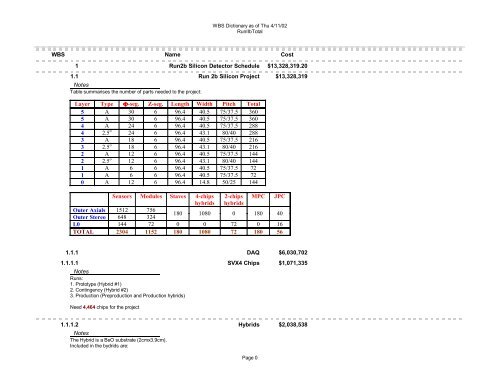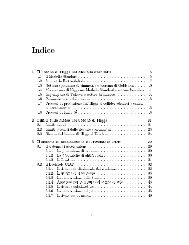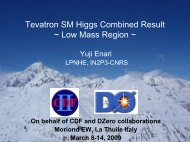Microsoft Project - WBS Dictionary - CDF
Microsoft Project - WBS Dictionary - CDF
Microsoft Project - WBS Dictionary - CDF
You also want an ePaper? Increase the reach of your titles
YUMPU automatically turns print PDFs into web optimized ePapers that Google loves.
<strong>WBS</strong> Name Cost<br />
1 Run2b Silicon Detector Schedule $13,328,319.20<br />
1.1 Run 2b Silicon <strong>Project</strong> $13,328,319<br />
Notes<br />
Table summarises the number of parts needed to the project:<br />
Layer Type Φ-seg. Z-seg. Length Width Pitch Total<br />
5 A 30 6 96.4 40.5 75/37.5 360<br />
5 A 30 6 96.4 40.5 75/37.5 360<br />
4 A 24 6 96.4 40.5 75/37.5 288<br />
4 2.5 o 24 6 96.4 43.1 80/40 288<br />
3 A 18 6 96.4 40.5 75/37.5 216<br />
3 2.5 o 18 6 96.4 43.1 80/40 216<br />
2 A 12 6 96.4 40.5 75/37.5 144<br />
2 2.5 o 12 6 96.4 43.1 80/40 144<br />
1 A 6 6 96.4 40.5 75/37.5 72<br />
1 A 6 6 96.4 40.5 75/37.5 72<br />
0 A 12 6 96.4 14.8 50/25 144<br />
Sensors Modules Staves 4-chips 2-chips MPC JPC<br />
hybrids hybrids<br />
Outer Axials<br />
Outer Stereo<br />
1512<br />
648<br />
756<br />
324<br />
180 1080 0 180 40<br />
L0 144 72 0 0 72 0 16<br />
TOTAL 2304 1152 180 1080 72 180 56<br />
1.1.1 DAQ $6,030,702<br />
1.1.1.1 SVX4 Chips $1,071,335<br />
Notes<br />
Runs:<br />
1. Prototype (Hybrid #1)<br />
2. Contingency (Hybrid #2)<br />
3. Production (Preproduction and Production hybrids)<br />
Need 4,464 chips for the project<br />
1.1.1.2 Hybrids $2,038,538<br />
Notes<br />
The Hybrid is a BeO substrate (2cmx3.9cm).<br />
Included in the bydrids are:<br />
<strong>WBS</strong> <strong>Dictionary</strong> as of Thu 4/11/02<br />
RunIIbTotal<br />
Page 0
<strong>WBS</strong> Name Cost<br />
"Hybrids" continued<br />
Notes<br />
1. 4 SVX4 chips.<br />
2. miscellanea components (capacitors,resistors, thermistor).<br />
Runs (4 chips hybrids):<br />
1. Prototype#1 (milestone #1 "electrical stave test")<br />
2. Protoype#2-Contingency (milestone #2 "contingency electrical stave test")<br />
3. Preproduction (milestone #3 "preproduction electrical stave test")<br />
4. Production (milestone #4 "Production electrical stave test")<br />
Need 1,080 4-chips hybrids and 72 2-chips hybrid for the project<br />
1.1.1.2.1 Outer layers $1,752,946<br />
Notes<br />
Runs (4 chips hybrids):<br />
1. Prototype (milestone #1 "prototype electrical stave test"), Proto#1 chip<br />
2. Contingency (milestone #2 "contingency electrical stave test"), Proto#2 chip<br />
3. Preproduction (milestone #3 "preproduction electrical stave test"), Production chips<br />
4. Production (milestone #4 "Production electrical stave test"), Production chips<br />
Need 1,080 hybrids<br />
1.1.1.2.2 Layer 0 $285,592<br />
Notes<br />
Runs:<br />
1. Prototype<br />
2. Production<br />
Need 72 2-chips hybrids.<br />
1.1.1.3 Bus Cables $61,502<br />
Notes<br />
Outer layer Bus cable is a Kapton based cable with signal and power traces to electrically connect the mini-PC to the hybrids. It also provides a ground shield plate to minimise noise<br />
pick-up from the sensors and the sensor bias connection.<br />
Runs:<br />
1. Prototype (milestone #1 "electrical stave test")<br />
2. Preproduction (milestone #3 "Preproduction electrical stave test")<br />
3. Production ( milestone #4 "Production electrical stave test")<br />
Need 360 bus cables for the project.<br />
Labor:<br />
All LBL labor. No FNAL efforts for the Bus Cable<br />
<strong>WBS</strong> <strong>Dictionary</strong> as of Thu 4/11/02<br />
RunIIbTotal<br />
Page 1
<strong>WBS</strong> Name Cost<br />
1.1.1.4 Mini Port Card $614,181<br />
Notes<br />
The MPC is a BeO hybrid (2"x1.55"). Included in the miniportcards are:<br />
1. components (including tranciever chips), connectors etc.<br />
2. short kapton cables (2 cables, one for power and one for data)<br />
3. cable wing (one kapton cable that connects the top MPC to the bottom stave bus cable)<br />
Runs:<br />
1. Prototype (milestone #1 "electrical stave test")<br />
2. Contingency (milestone #2 "contingency electrical stave test")<br />
3. Preproduction (milestone #3 "preproduction electrical stave test")<br />
4. Production (milestone #4 "Production electrical stave test")<br />
Need 180 Mini Port Cards for the project<br />
1.1.1.5 Junction Port Cards $315,902<br />
Notes<br />
The JPC is an FR4 board (possibly 2 boards) for signal and power distribution.<br />
JPC includes:<br />
1. components (capacitors, resistors, power filters, FPGA, connectors etc.)<br />
Runs:<br />
1. Prototype#1 (milestone#1 "prototype electrical stave test")<br />
2. Prototype#2 - contingency<br />
2. Preproduction (milestone#3 "preproduction electrical stave test")<br />
3. Production (milestone#4 "production electrical stave test")<br />
Each port card can serve up to 5 mini-PC.<br />
Total number of JPC for the project (inlcuding L0) is 46.<br />
<strong>WBS</strong> <strong>Dictionary</strong> as of Thu 4/11/02<br />
RunIIbTotal<br />
Page 2
<strong>WBS</strong> Name Cost<br />
"Junction Port Cards" continued<br />
Notes<br />
Junction Port Cards<br />
Layer Φ -seg. MPC<br />
JPC<br />
(each side)<br />
(Total)<br />
5<br />
5<br />
30<br />
30<br />
30 12<br />
4<br />
4<br />
24<br />
24<br />
24 10<br />
3<br />
3<br />
18<br />
18<br />
18 8<br />
2<br />
2<br />
12<br />
12<br />
12 6<br />
1<br />
1<br />
6<br />
6<br />
6 4<br />
0 12 0 6<br />
Total JPC 46<br />
1.1.1.6 Junction Cards $135,934<br />
Notes<br />
This is a passive card (or just a simple connector) that allows the cable transition from inside to outside of the tracking volume (it's roughly located where we now have the Junction<br />
Cards for runiia). It should not have any components but it could have some power filtering.<br />
This card is linked to the finilization of the mechanical structure which dictates dimensions and support. This is the reason for having 2 prototypes.<br />
Runs:<br />
1. Prototype#1 (just functionality)<br />
2. Prototype#2 (specified for the final mechanical design)<br />
3. Production<br />
1 JC per stave + L0<br />
Need 180 (Outer) + 24 (L0) = 204 Junction Cards for the project.<br />
<strong>WBS</strong> <strong>Dictionary</strong> as of Thu 4/11/02<br />
RunIIbTotal<br />
1.1.1.7 Cables $320,541<br />
Notes<br />
We will replace all cables going from the silicon detector to the DAQ and Power Supplies racks.<br />
There are 2 sets of these cables:<br />
• from the mini Port Card (end of stave) to the Junction Port Card<br />
• from the Junction Port Card to the racks.<br />
Page 3
<strong>WBS</strong> Name Cost<br />
1.1.1.7.1 Cables from MPC to JPC $173,371<br />
Notes<br />
These are in reality 2 sets of cables.<br />
One set from the end of the MPC pig-tail to the Junction card (signal + power) and a second set from the Junction card to the Junction Portcard (signal + power).<br />
First set is about 3 feet long<br />
Second set is about 9 feet long.<br />
The Junction Card connects the 2 sets.<br />
In production we will need 180*2 = 360 sets of cables.<br />
1.1.1.7.2 Cables from JPC to Crates $147,170<br />
Notes<br />
There are 4 types of cable:<br />
1. signal (JPC to FTM/FIB)<br />
2. power (JPC to Power Supply)<br />
3. High Voltage (JPC to Power Supply)<br />
4. sensing wire for the LV power (JPC to Power Supply)<br />
The High Voltage cable and sense cable could be the same as the Power cable (all going to Power Supplies).<br />
Total length is about 60 feet.<br />
1.1.1.8 FTMs $183,707<br />
Notes<br />
New FTMs are needed because we are not using optical transmitter/receiver for the data.<br />
Old FTMs can be easily made "new" by simply substituting the old optical tx/rx part with standard tx/rx.<br />
Here we estimate the highest price of making a complete new card.<br />
There is one FTM every 2 JPC.<br />
Runs:<br />
1. Prototype<br />
3. Production<br />
Need 23 FTM for the project<br />
<strong>WBS</strong> <strong>Dictionary</strong> as of Thu 4/11/02<br />
RunIIbTotal<br />
1.1.1.9 DAQ Testing & Readiness $173,748<br />
Notes<br />
Cost:<br />
Here is the cost of all electrical testing (M&S) at FNAL. Includes DAQ stands, Burn-in stations, computers, miscellanea PC boards and material, cables, tools and instrument<br />
(oscilloscope etc. is needed).<br />
added 50% contingency<br />
1.1.1.10 Power Supply system $733,114<br />
1.1.1.11<br />
Notes<br />
SVT upgrade $382,200<br />
The SVT is part of the trigger system for <strong>CDF</strong>. The upgrade consists in making more of boards already existing and/or modifying existing boards.<br />
University of Chicago and INFN-Pisa are providing engineering time, labor and equipment for these parts.<br />
Page 4
<strong>WBS</strong> Name Cost<br />
1.1.2 Sensors $2,296,246<br />
Notes<br />
The table below summarises the type and number of sensors needed:<br />
Silicon Sensors<br />
<strong>WBS</strong> <strong>Dictionary</strong> as of Thu 4/11/02<br />
RunIIbTotal<br />
Layer Type Φ-seg. Z-seg. Length Width Pitch Total<br />
5 A 30 6 96.4 40.5 75/37.5 360<br />
5 A 30 6 96.4 40.5 75/37.5 360<br />
4 A 24 6 96.4 40.5 75/37.5 288<br />
4 2.5 o 24 6 96.4 43.1 80/40 288<br />
3 A 18 6 96.4 40.5 75/37.5 216<br />
3 2.5 o 18 6 96.4 43.1 80/40 216<br />
2 A 12 6 96.4 40.5 75/37.5 144<br />
2 2.5 o 12 6 96.4 43.1 80/40 144<br />
1 A 6 6 96.4 40.5 75/37.5 72<br />
1 A 6 6 96.4 40.5 75/37.5 72<br />
0 A 12 6 96.4 14.8 50/25 144<br />
Sensors Quantity Total (+ 20% spares)<br />
Outer Axials 1512 1814<br />
Outer Stereo 648 778<br />
L0 144 172<br />
TOTAL 2304 2764<br />
1.1.2.1<br />
Notes<br />
We are going to prototype the outer stereo and Axials sensors.<br />
Runs:<br />
Outer layers $2,150,566<br />
1. Prototypes Axials and Small Angle Stereo (30 grade "A"+30 grade "B" each)<br />
2. Production (Axials, SAS and L0)<br />
Page 5
<strong>WBS</strong> Name Cost<br />
"Outer layers" continued<br />
Notes<br />
Need 1512 Axials and 648 Small Angle Stereo for the project.<br />
1.1.2.2 layer L0 $145,680<br />
Notes<br />
Given the small number of detectors needed and the use of the same technology as for the Outer sensors we order directly the production.<br />
Need 144 for the project.<br />
1.1.3 Construction (Modules and staves) $2,241,206<br />
Notes<br />
added 50% cont. to cost on each costed item<br />
<strong>WBS</strong> <strong>Dictionary</strong> as of Thu 4/11/02<br />
RunIIbTotal<br />
1.1.3.1 L0 Construction (cables and modules) $499,738<br />
Notes<br />
Required quantity for the L0 detector is 72 modules. We should schedule and cost 100 production modules based on the L00 experience<br />
1.1.3.1.1 L0 analogue signal cables $307,882<br />
Notes<br />
THese are the analogue signal cables L00 style.<br />
We assume we will have 2 long (580mm), 2 medium (400mm) and 2 short (220mm) cables per sector (12*2 sectors in total).<br />
Runs:<br />
1. many small test run just to adjust the process<br />
2. preproduction<br />
3. production<br />
1.1.3.1.2 layer 0 modules $191,856<br />
1.1.3.2<br />
Notes<br />
Outer layer modules $537,827<br />
It consists of 2 sensors glued together "head-on". On top of one sensor one hybrid and one pitch adapter is also glued. Module is wirebonded and put on a G-10 frame for testing.<br />
Need 882 modules for the project.<br />
1.1.3.3 Outer layer Staves $1,203,641<br />
1.1.4 Beampipe $237,771<br />
Notes<br />
The beampipe is designed to be compatible with the old pipe (it has the same flanges to connect to the Tevatron beampipe). It is constructed from Beryllium for low mass, with short<br />
stainless steel sections on the end. We are considering a drilled technology rather than the traditional rolled technique. The pieces are the same OD and ID as the D0 pipe to minimize<br />
the total cost of the<br />
<strong>CDF</strong> + D0 pipe. The pipes are not identical, <strong>CDF</strong>s is longer and has different flanges on the end.<br />
Page 6
<strong>WBS</strong> <strong>Dictionary</strong> as of Thu 4/11/02<br />
RunIIbTotal<br />
<strong>WBS</strong> Name Cost<br />
1.1.5 Support Mechanics $1,579,240<br />
Notes<br />
This section covers infrastucture, the support structures for the staves, barrels, L0, and transportation and installation at B0.<br />
50% cont. is included on all costed items<br />
1.1.5.1<br />
Notes<br />
Added appropriate contingency to all costed items<br />
Mechanical Infrastructure $200,000<br />
1.1.5.2 Silicon Support Structures $1,134,490<br />
Notes<br />
This task covers the bulkheads which support the staves, the screens which attach the bulkheads to each other, the tube which supprts the barrels (spacetube in Run IIa) and the<br />
support structure for L0.<br />
1.1.5.2.1<br />
Notes<br />
This task is comprehensive of:<br />
Bulkheads $437,999<br />
1. 2 external and 2 internal CF bulkheads with precision Berillium (internal) and Al (external) mounting features.<br />
2. inner screen<br />
3. fixtures for holding/aligning the bulkheads together<br />
1.1.5.2.2<br />
Notes<br />
These are the Inner and Outer screens for the outer barrel.<br />
screens $398,746<br />
1.1.5.2.3<br />
Notes<br />
Layer 0 $297,745<br />
This is the Carbon Fiber Support for L0. It is mounted on outer bulkheads and has an integrated cooling system. This includes the structure which supports and cools the hybrids<br />
ouside the end of the barrel.<br />
1.1.5.3<br />
Notes<br />
Transportation Fixtures $67,636<br />
This is the fixture for transporting ISL+SVXIIa or ISL+SVXIIb from/to the Assembly Hall.<br />
It has to be finished before runiia ends. The fixtures for Run IIa will be reused as much as possible<br />
1.1.5.4<br />
Notes<br />
Positioning system (inchworms) $66,009<br />
This system allows adjustment of the position of the entire silicon detector (ISL+SVXIIb+L0+ beampipe) relative the the outer tracker (COT) and the beamline.<br />
1.1.5.5 Installation of SVXIIb into ISL $111,105<br />
Notes<br />
These are the fixtures that allows for both extracting SVXIIa from IL and inserting SVXIIb into ISL.<br />
Schedule:<br />
Page 7
<strong>WBS</strong> Name Cost<br />
"Installation of SVXIIb into ISL" continued<br />
Notes<br />
This task needs to be done in time for the removal of SVXIIa from ISL<br />
<strong>WBS</strong> <strong>Dictionary</strong> as of Thu 4/11/02<br />
RunIIbTotal<br />
1.1.6 Cooling and Monitoring $213,238<br />
Notes<br />
Thisi task covers the cooling system, the monitoring of the cooling and power to the detectors and the position monitors (RASNIKS)<br />
50% cont. is included on all costed items<br />
1.1.6.1<br />
Notes<br />
Cooling systems $153,238<br />
This task covers updating the cooling system at Sidet and B0 and the cost of new manifolds at the detector.<br />
1.1.6.2<br />
Notes<br />
Interlocks $30,000<br />
This is the system that montors the power and temperature of the detectors.<br />
It will resue most of the existing system.<br />
1.1.6.3 Position Monitoring $30,000<br />
Notes<br />
This is to update the esisting position monitoring system (RASNIK).<br />
Cost is based on Run IIa experience and resuing the DAQ already setup.<br />
Labor:<br />
there is no FNAL labor for this task, Toronto is taking on this project<br />
1.1.7<br />
Notes<br />
Final Assembly (Installation and Integration) $676,943<br />
This task covers installation of staves into the barrels, installation of L0 modules on the CF supports<br />
and the integration of L0 and beampipe with the outer barrel<br />
Added 50% contingency to all costed items<br />
1.1.7.1<br />
Notes<br />
This covers installation of all layers except for L0.<br />
Stave Intallation (Outer) $317,855<br />
1.1.7.2 L0 Installation (Inner) $150,645<br />
1.1.7.3<br />
Notes<br />
Integration $208,444<br />
This task incudes the fixtures and labor associated with installing the inner detector (L0) into the outer barrel. All costs and labor are estimated based on Run IIa experience<br />
1.1.8 Transportation and Installation $52,974<br />
Page 8
<strong>WBS</strong> Name Cost<br />
"Transportation and Installation" continued<br />
1.2 Central Preshower $945,050.28<br />
Notes<br />
Summary task for the Central Preradiator detector<br />
1.2.2 Procure parts $667,825.00<br />
Notes<br />
Summary task for the procurement of all the parts needed for the detector<br />
1.2.2.5 CPR Detector parts $132,133.00<br />
Notes<br />
Summary task for the parts included in the detector modules.<br />
1.2.2.6 CCR Detector parts $25,656.00<br />
Notes<br />
Summary task for the parts needed in the Crack Chamber modules.<br />
1.2.3 CPR Detector Assembly $102,915.28<br />
Notes<br />
Summary task for the assembly of the CPR modules.<br />
1.2.4 CCR Detector Assembly $19,076.00<br />
Notes<br />
Summary task for the construction of the Central Crack chamber modules.<br />
1.2.5 Fiber Bundles $54,000.00<br />
Notes<br />
Physicist estimate.<br />
<strong>WBS</strong> <strong>Dictionary</strong> as of Thu 4/11/02<br />
RunIIbTotal<br />
1.3 Run IIb Data Acquisition project $1,199,907.20<br />
Notes<br />
Data Aquisition project is mostly the upgrade of the level3 and event builder systems plus some minor upgrade in the computing related.<br />
1.3.1 Even\t-Builder Upgrade $557,411.20<br />
Notes<br />
The Event Builder upgrade is based on the same technology as the first one except for increased bandwidth. This path has been chosen since the increase in throughput and rate a<br />
mild and using the same technology minimizes the effort needed for the upgrade.<br />
The details of the purchase and all parts are assumed to be equal to the purchase of the present Event Builder hardware. According to somewhat outdated quotes the hardware costs<br />
about 500k.<br />
Contingency is included in the sense that these are old quotes and the hardware will only become cheaper, although not by much.<br />
Page 9
<strong>WBS</strong> Name Cost<br />
"Even\t-Builder Upgrade" continued<br />
Notes<br />
Further Details on the Hardware from a quote from December 2001<br />
Raw cost<br />
32 port ASX 4000 (Marconi) $215k<br />
16 OC12 PCI cards (ForeRunnerHE 622) $30k<br />
15 OC-12 PMC carss (Cyclonwe PMC59) $60k<br />
Total $305k<br />
Spares<br />
1 Spare switch backbone $51k<br />
1 Spare switch module $40k<br />
3 Spare PCI cards $6k<br />
3 Spare ATM cards $12k<br />
Total $109k<br />
Total including spares $414k<br />
Including 30% contingency $538k<br />
<strong>WBS</strong> <strong>Dictionary</strong> as of Thu 4/11/02<br />
RunIIbTotal<br />
1.3.1.1<br />
Notes<br />
upgrade software $7,280.00<br />
One postdoc/researcher type is needed 100% of the time to work on this project. Probably a second person will split the work with this person and both work 50% of their time.<br />
1.3.1.2 renew infrastructure $6,806.40<br />
Notes<br />
Two students are needed 50% of their time to disassemel the system. A electrician is needed in case the AC needs to be upgraded (bring this up in the meeting).<br />
1.3.1.3 construct prototype $134,916.00<br />
Notes<br />
Installation and commissioning of the prototype system will be done by two students using 50% of their time supervised by a postdoc/researcher type.<br />
1.3.1.3.1 purchase prototype system (1/4) $134,500.00<br />
1.3.1.4 construct full size system $404,332.00<br />
Notes<br />
Similar to the construction of the prototype two students with 50% of their time supervised by a postdoc/researcher type.<br />
1.3.1.4.1 purchase remaining hardware $403,500.00<br />
Page 10
<strong>WBS</strong> Name Cost<br />
"purchase remaining hardware" continued<br />
<strong>WBS</strong> <strong>Dictionary</strong> as of Thu 4/11/02<br />
RunIIbTotal<br />
1.3.1.5 commission the system $4,076.80<br />
Notes<br />
System commissioning is an intense task and has constraints with other systems. The two students and the postdoc/researcher type have to work 100% of their time to commission<br />
the system.<br />
1.3.2<br />
Notes<br />
Computer for Level3 PC Farm / DAQ $642,496.00<br />
Computer purchase is part of the operations but the cost is listed here for convenient tracking.<br />
We work with the assumption that every three years PCs become obsolete and have to be replaced.<br />
The assumption is that a computer costs about $1500. This number is probably going to be smaller since in the last years the computers have only gotten cheaper. Some farms group<br />
have bought computers recently for this price.<br />
It is not useful to get a more detailed quote at this point since the prices are going to vary.<br />
In terms of the human resources this project is rather light weight. The preparation work on the prototype takes 50% of the postdoc/researcher type plus 50% of one student. It takes<br />
two students 50% of their time supervised by a postdoc/researcher type to complete the installation and commissioning.<br />
1.3.2.1 replace 70/15 PCs (2002) $160,624.00<br />
1.3.2.2 replace 70/15 PCs (2003) $160,624.00<br />
1.3.2.3 replace 70/15 PCs (2004) $160,624.00<br />
1.3.2.4 replace 70/15 PCs (2005) $160,624.00<br />
1.4 Calorimeter upgrades $204,480.00<br />
1.4.1 Electromagnetic timing $204,480.00<br />
1.4.1.1 Research and Development $0.00<br />
1.4.1.1.1 Prototype Test Stand $0.00<br />
1.4.1.1.9<br />
Notes<br />
Test ASD->TDC Cables $0.00<br />
Test cables if they can carry a signal to TDC before ordering<br />
1.4.1.1.10 Test ASD System $0.00<br />
1.4.1.1.12 Test TDC Boards $0.00<br />
1.4.1.2 Procure parts $204,480.00<br />
1.4.1.2.1 Miscellaneous $29,744.00<br />
Page 11
<strong>WBS</strong> Name Cost<br />
"Miscellaneous" continued<br />
1.4.1.2.2 Cables $22,536.00<br />
1.4.1.2.3 Electronics $152,200.00<br />
1.4.1.2.3.13 Build CEM+PEM ASD Boards $60,000.00<br />
1.4.1.2.3.18 Build CEM+PEM Transition Boards $19,600.00<br />
1.4.1.2.3.27 VME Crate - first floor $15,000.00<br />
1.4.1.2.3.33 TDC Boards $57,600.00<br />
1.8 Installation of Run IIb $555,437.00<br />
1.8.1 Roll Out From Run 2A $44,205.60<br />
1.8.1.1 Preparations for Roll Out $14,714.80<br />
1.8.1.2 Roll out Process $29,490.80<br />
1.8.2 Assembly Hall Tasks $395,799.20<br />
1.8.2.1 Misc Cable Installation $98,272.00<br />
1.8.2.2 Upgrade Silicon Controls and Interlocks $115,822.00<br />
Notes<br />
Estimate to replace SVX & ISL Simatic with APACS and Quad<br />
General philosophy<br />
Read all bulkhead temperatures with Quadlog and trip if too hot<br />
Read all bulkhead pressures with Quadlog and trip if too high.<br />
Evaluate critical portions per ANSI S84.01<br />
APACS provides monitoring, control, first stage interlocks<br />
Task ngineeringtechnician<br />
Rewire 471 devices 2 3<br />
configure 471 I/O 1<br />
configure logic 2<br />
checkout 1 2<br />
FIX data base 0.5 2<br />
FIX pictures 0.5 1<br />
Safety Life Cycle evaluation 1<br />
external reviews 0.5<br />
<strong>WBS</strong> <strong>Dictionary</strong> as of Thu 4/11/02<br />
RunIIbTotal<br />
Page 12
<strong>WBS</strong> Name Cost<br />
"Upgrade Silicon Controls and Interlocks" continued<br />
Notes<br />
Spreadsheet from email message from Rich Schmitt dated April 25, 2001<br />
My guess is that this is too low an estimate both in $$$ and effort<br />
ITs probably a couple of weeks just to write the new wiring list from HR rack to quadlog<br />
1.8.2.3 Cryo Platform $16,424.40<br />
1.8.2.4 Improve Access to Silicon Racks $18,353.60<br />
1.8.2.5 Flammable Gas $36,048.00<br />
1.8.2.6 SVXII Removal $18,484.00<br />
1.8.2.7 Preradiator Installation $40,147.60<br />
1.8.2.8 Calorimeter Timing $41,068.00<br />
1.8.2.9 SVX III Installation $11,179.60<br />
1.8.3 Run IIB Roll in $64,612.20<br />
1.8.3.1 Central Detector installation $31,203.00<br />
1.8.3.2 Connections and Checkout $11,896.00<br />
1.8.3.3 Complete Silicon Installation $10,872.00<br />
1.8.3.4 Prepare to Exit Collision Hall $10,641.20<br />
1.9 Administration $466,480.00<br />
Notes<br />
This summary task covers all the administrative costs associated with the design and construction of the <strong>CDF</strong> Run IIb project.<br />
1.9.1 Fiscal Years $0.00<br />
Notes<br />
This summary task will hold tags for the Fiscal years.<br />
<strong>WBS</strong> <strong>Dictionary</strong> as of Thu 4/11/02<br />
RunIIbTotal<br />
1.9.2 Design Phase $65,500.00<br />
Notes<br />
This task covers all the administrative costs associated with the design phase of the project. This task will be complete when the project has been baselined, and received CD-3.<br />
1.9.2.1 Miscellaneous $50,500.00<br />
Page 13
<strong>WBS</strong> <strong>Dictionary</strong> as of Thu 4/11/02<br />
RunIIbTotal<br />
<strong>WBS</strong> Name Cost<br />
1.9.3 Construction Phase $400,980.00<br />
Notes<br />
This summary task covers the administrative costs incurred during the construction phase of the project. It will be complete when the construction of all other subprojects is complete.<br />
1.9.3.1 Miscellaneous $400,980.00<br />
1.9.3.1.1 Visitors $75,000.00<br />
1.9.3.1.2 Travel $90,000.00<br />
2 CPR2April10 $945,050.28<br />
3 tempDAQ $1,199,907.20<br />
4 EMTimingOct01 $204,480.00<br />
5 I & I V3.0 $555,437.00<br />
6 AdminJan02 $466,480.00<br />
Page 14






